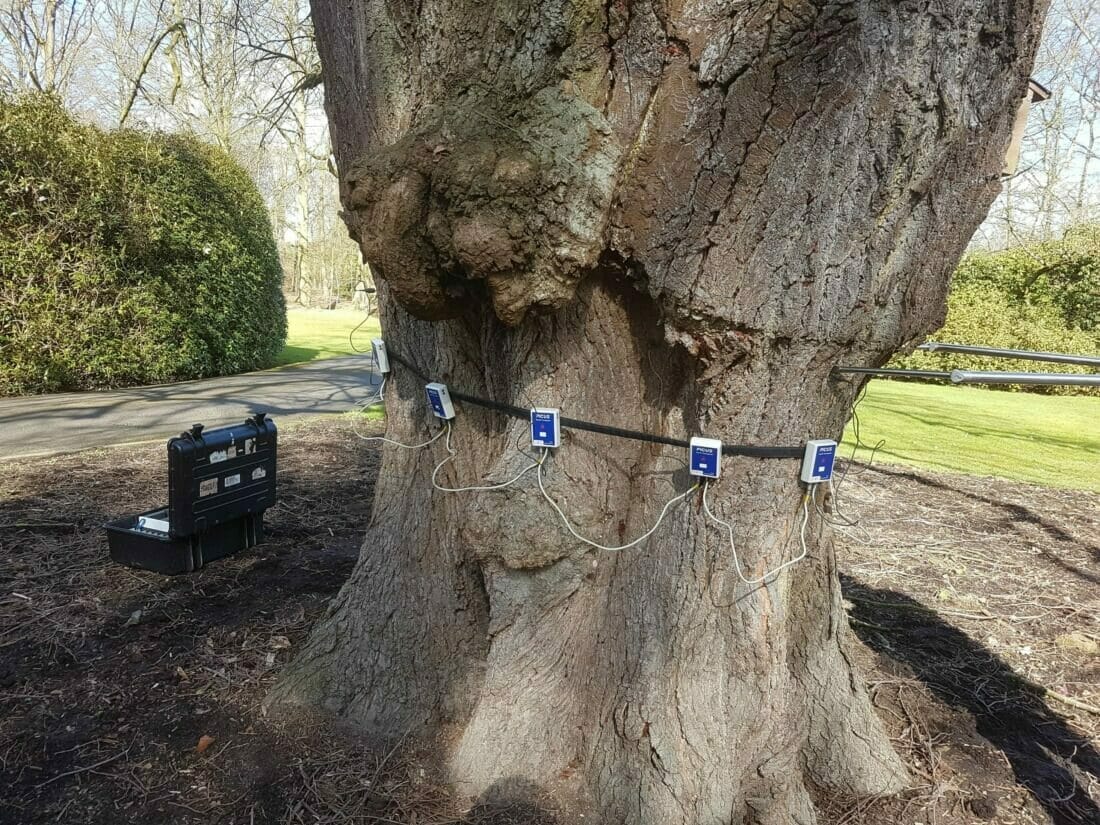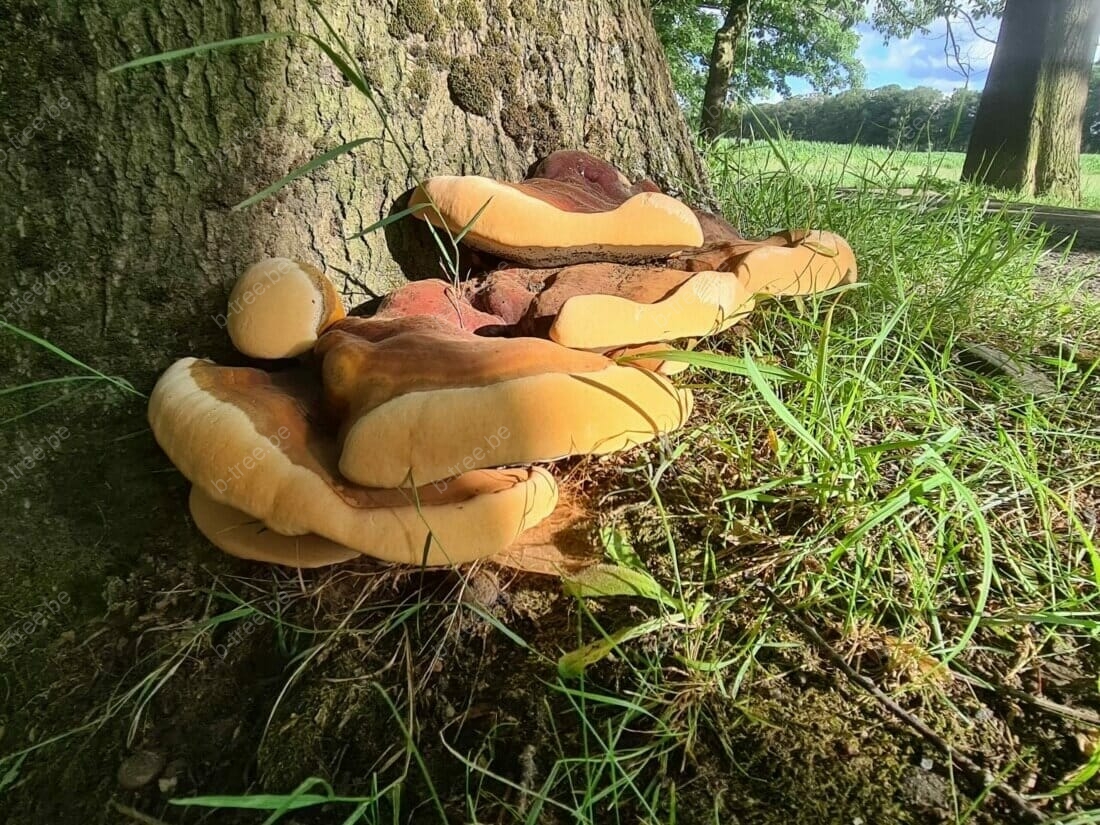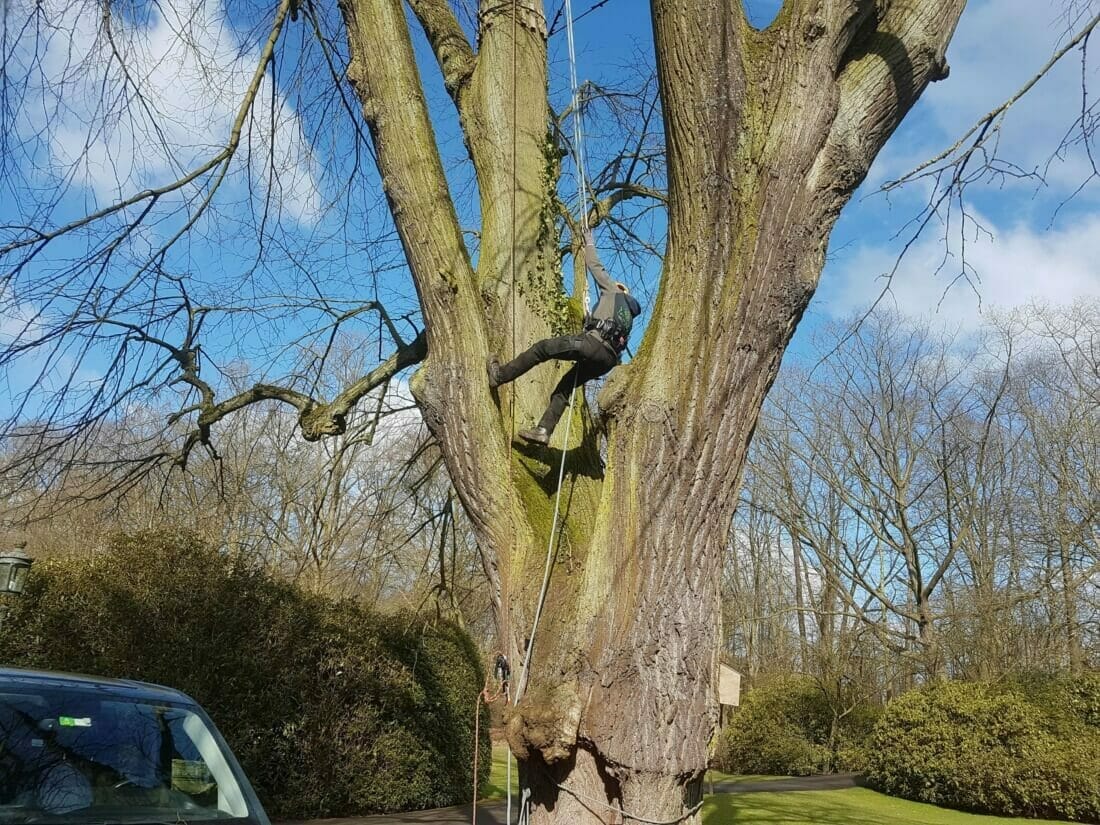



Tree inspection, VTA check and MTA check
Why perform a tree inspection?
The question of tree inspection or VTA control often arises when owners or managers are concerned about the safety of their trees.
And when fungal fruiting bodies are present on or near a tree. And then an MTA check is also very useful. Not only because fungi often influence the mechanical strength (read weakening). But they also provide a lot of additional information. Which a mere VTA check does not always provide.
And rightly so, because if an accident were to happen with the breakage or windthrow of a tree, the owners or managers could be held liable for the damage.
But when the tree owner or manager has a tree safety check or tree inspection, he has acted with due diligence. And the chance of unexpected things happening with the next storm becomes much smaller. Because a VTA inspection also provides for measures, such as the timely felling of mechanically weakened trees.
There are also other important reasons why you should perform a tree inspection. This is how you contribute tree management on a large scale, such as when drawing up a tree plan, or when drawing up one Tree Effect Analysis, a VTA check for each tree.
This gives you the correct overview of which trees require the highest priority in connection with tree safety.
Also as tree technical advisor we carry out tree inspections to determine the correct nature of the tree in legal disputes condition and demonstrate the vitality of a tree.
As an arborist, you inspect the tree before working on it
Before you if arborist starts working on or around trees, you want to know whether you are setting the right priorities. Both with the choice of which trees you give your attention to first, and what you are going to do with an individual specimen. You go one tree pruning, then you always carry out a VTA check or tree inspection. So you know whether the tree can be pruned or not. And that it is safe to climb in.
By inspecting the trees by means of a VTA inspection or tree safety check, you can clearly map out these two different priorities. You invest your money with the maximum return. Maximum tree safety at the lowest cost. Because you can clearly set and weigh the right priorities against each other. The tree inspections and prioritization are done by us Certified Tree Manager.
Additional reasons for inspecting trees
You also wish the condition and vitality of a tree know before you go pruning or climbing. You want to know that the tree will be able to overgrow the pruning wounds afterwards (callus formation) or will not break if you work in the crown while climbing. arborist. A tree with a poor condition or a poor vitality has different needs than a very vital tree. You don't go for a tree in poor condition pruning, but give you a growth site improvement.
An additional reason for carrying out a VTA check and making an inspection report is that you notice in time that trees are in their final phase. And then you can plan in time to plant young trees as successors. Which over time, as a future tree, takes the place of the dying tree.
In summary, before any work is carried out on or around trees, you wish them condition and vitality. This is to be able to set the right priorities. By pruning, tot cut down or remove or new ones planting trees. You do this by first doing a VTA check or tree safety check to be carried out. VTA checks are carried out by our Certified Tree Manager and our skilled tree care staff.
An example of a tree inspection
When a tree has a declining crown, the condition of the tree poor. The tree has branches with dead ends in its crown; no leaves and rotten wood. This has a cause. Often this is due to a poor location or soil compaction.
Suppose the boom were to be taken even further pruning, for purely temporary aesthetic reasons, and removes the dying ends. The tree will then only be put under even more physiological and pathological stress by the additional pruning wounds. In addition to the bad location which is already undermining the tree and causing root damage.
Thoroughly inspecting the tree and its surroundings will then reveal the real root cause of the poor condition. This will quickly make it known that there is one, for example location improvement is needed instead of one pruning.
This example is very clear. But often there are other defects or factors that are more difficult to find when inspecting trees.
Taking into account the qualitative properties of the tree's environment, information about its nature location and growth location and the history, going back decades of what happened in the root zone, is therefore necessary during a tree inspection.
More and correct data leads to a better analysis and a more appropriate approach to the trees.
So don't postpone a tree inspection, but take it in a timely manner Contact with us.
Knowledge, the difference between the correct or incorrect assessment of the tree
There are fungi that live in symbiosis with trees. Let us call them the “good fungi”, but the others are just as good. More about that in a moment. The symbionts support the trees and provide them with more water, nutrients, natural fungicides and other substances that protect them against insects and pests.
And there are fungi that live on the living wood of trees, the parasites or “cleaners”. They are process accelerators in the tree species' own ecosystem and help weakened trees die more quickly. So that the wood is fed to the still living trees, via the symbionts, throughout the recycling process of nutrients in the soil food web. So good fungi as well.
Both types of fungi have their functions and are both equally important. Because without the symbionts there would be no trees, and without the scavengers there would be no nutrients for the living trees. So no trees either.
During a tree inspection it is therefore important to: parasitic fungi that can attack living wood, and to correctly recognize this mechanical weakening. So that a mechanically unstable tree can be anticipated in time. By the to prune tree for example or by the tree to fell.
The effect of each fungus on the tree differs, also depending on the tree species
The fungi that are present must therefore be correctly recognized and cataloged during a VTA check and MTA check.
This is necessary to get an accurate picture of the condition where the tree is located.
And to make a correct assessment of the possible long-term conservation of an individual tree.
Our tree manager is well informed about the mycological events between trees and fungi and can advise you correctly tree advice grant.
Because every fungus has a different effect on a specific type of wood. Some fungi cause white rot, brown rot, simultaneous rot or white rot with selective delignification. All these types of wood rot have a different influence on the mechanical stability, a different attack rate and therefore also require different safety measures.
Every fungus present tells something about the condition of the tree. In this way, the needs of the tree also become known. And can be made through the correct diagnosis, the most suitable treatment or measures. Especially if you want to keep the tree safely for as long as possible.
When inspecting trees, knowledge about fungi, the many other physiological and mechanical factors, and their interplay is therefore indispensable. It is one of the main tasks of a tree manager, to be able to correctly assess a tree.
What is a VTA (Visual Tree Assessment) check?
A VTA check (Visual Tree Assessment) is the non-destructive inspection of a tree.
Possibly supplemented with one MTA control.
During the VTA check, the tree is checked and assessed on many parameters. All this by a skilled person tree technical advisor which is located on the ground floor.
A VTA inspection is not carried out using an aerial work platform or climbing. Maybe later during further investigation.
During the visual tree survey or the VTA check, the following parameters of the tree are assessed, among others:
- page setting
- leaf color
- shoot length
- size of the fruits
- crown architecture and structure
- crown quality
- there is branch death
- cavities
- rotting
- mechanical damage
- heavy elbow branches
- heavy pistons
- cracks
- torsions
- root system
- strangler roots
- location
- wound overgrowth
- reaction wood
- ...
Which tools do you use for a VTA check or tree inspection?
During a VTA check you want to find out as much as possible and yet in a simple way about the condition of the tree.
Small simple tools such as a prod, binoculars, measuring tape, wooden hammer, a sturdy knife and hand pruning shears can provide you with a lot of information.
The wooden hammer is very useful in detecting cavities in the trunk, trunk base, root formations and even the roots if they are large enough and partly above ground.
We use the stick to measure the depth of a rot. Or to determine whether a piece of exposed heartwood has not become rotten due to fungal attack.
We also use the spike stick to measure the penetration resistance of the soil in the crown projection of the tree.
This is not an exact measurement, but provides an initial indication of the soil conditions during the tree inspection.
If there is any doubt and we suspect a compacted soil, we use our penetrometer, which displays exact values.
Simple tools provide a lot of information for an inspection
By cutting a twig with a knife or pruning shears, the inside of the twig is visible.
Its condition may affect us in some cases attacks and/or species also provide more information about the condition of the tree.
And to be able to properly observe whether there is any death on the outside of the crown or whether there are budding buds everywhere, binoculars come in handy.
The bottom line is, the more information you can determine in a simple way, the better you can make a judgment about the tree.
A book about MTA (Mycological Tree Assessment) with a lot of information about which fungus has which effect on which tree species is also one of our tools. tree manager.
Some example situations of a VTA check or tree inspection
This inspection may then show that the tree has become very unstable, for example.
Or is sensitive to wind throw, trunk breakage or branch breakage. Also other features of the tree, such as a heavy elbow branch or plaque sludge can cause problems or an unsafe situation in the long term.
We store all this collected data in one report, together with the advice and mitigating measures. To take the right actions afterwards, also for follow-up in the following years.
It may also be that the life expectancy of a tree is still limited. For example, because of a fungal attack.
Such as in the advanced state of a tinder fungus infestation, where the fruiting bodies are already fully developed and are several years old.
Or as with the attack by a resin fungus or fire fungus.
And when these fruiting bodies are fully grown and numerous on the tree, the wood inside the tree is completely colonized by the mycelium.
As a result, no healthy wood remains.
Which causes serious stability problems to arise. The You will then have to cut down the tree urgently for safety reasons.
The result of the VTA check determines whether further investigation is necessary
Based on the non-destructive and visual inspection of trees by our tree expert it can be decided whether or not additional research is necessary. This is called further research.
Further research may include a resistography, tensile test, leaf analysis, chlorophyll fluorescence analysis, soil analysis, acoustic tomography, climbing inspection or other research.
Picus sound tomography and tensile test of the same veteran tree (linden) as further investigation, because the MTA control found a saddle mushroom (Polyporus squamosus), which makes the wood very fragile, in the cavity between the two trunk parts.
Increasing tree safety by inspecting trees on a regular basis
When a tree is no longer healthy, and its life expectancy is therefore rather limited, but the owner or manager of the tree still wishes to keep it safely for as long as possible, follow-up on a regular basis is necessary.
Inspection by our tree expert every 6 months, annually or every 2, 3 or maximum 4 years.
Provided that you take additional measures, such as anchoring, supporting, safety pruning or others.
This must always be considered and decided based on the current condition of the tree.
If a tree is sensitive to wind throw due to a severely damaged root or a large cavity in the trunk, monitoring will have to be done at very regular intervals.
As the condition of the tree is too poor, can even be a emergency hood or emergency felling needed.
A visual tree inspection tells a lot about both the condition like the vitality of a tree.
And it will certainly provide a definitive answer as to whether or not further research is needed.
What is an MTA check or “Mycological Tree Assessment”

When inspecting the tree we saw the fruiting body of a sulfur fungus on a Prunus serotina (bird cherry). The sulfur fungus is a brown rot and tells us during the VTA inspection and MTA inspection that the tree is severely affected. The attack can lead to trunk breakage.
MTA is a research method for inspecting a tree in which the condition of the tree is deduced and determined based on the fungi that occur on, around or near the tree.
All this is described in great detail in the book “Mycological Tree Assessment” by Gerrit-Jan Keizer, who is its founder.
During this tree survey or tree inspection, the main focus will be on the fungi present:
- both of these are present on the tree
- in the vicinity of the tree
- on dead branches
- in the root zone of the tree
- and it will be determined in which life stage the inspected tree is. This is based on the fungi that are present at that time because these fungi are very specific per life stage.
MTA control is based on the tree species' own ecosystem
The MTA methodology is based on the tree-specific ecosystem of trees, described, among others, by Gerrit-Jan Keizer in his book “The Hidden Tree”.
The tree inspection according to the MTA inspection goes much further than the ordinary visual tree inspection. And takes the future prospects of the tree much more into account.
Both books are highly recommended! You can read the book about MTA buy through Inverde. And you can book it Buy “The Hidden Tree” via A3 books.
If you would like to have your tree inspected, please do not hesitate to contact us contact.
